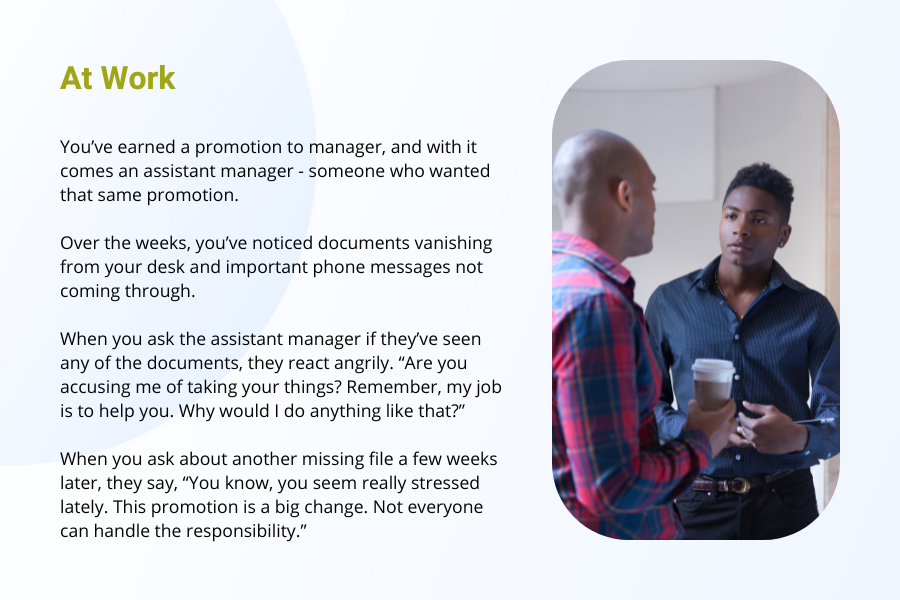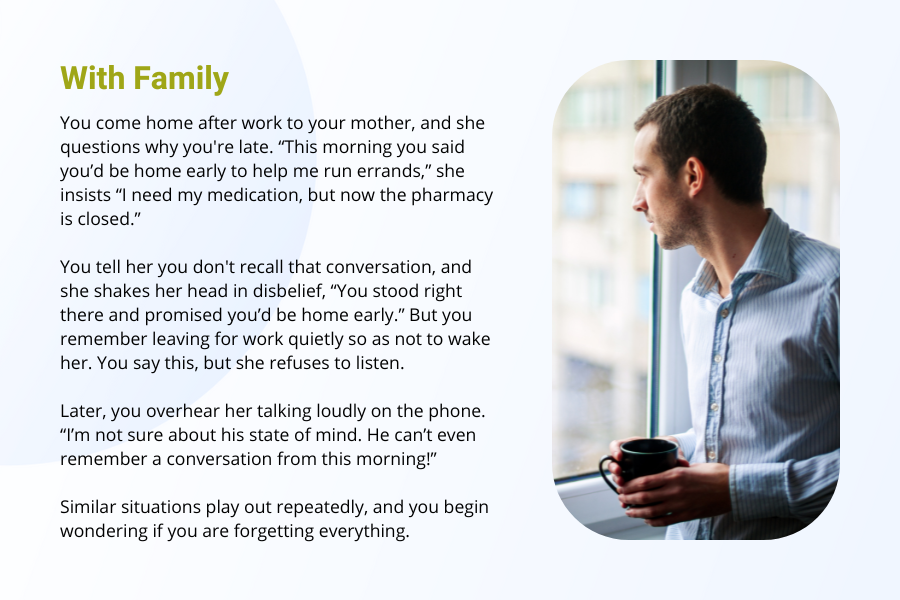What is gaslighting?
Gaslighting is a deliberate pattern of manipulation. A person who gaslights will intentionally and systematically feed you information that contradicts what you know to be true. The goal? To undermine your trust in yourself and crush your self-confidence, sowing a dependence on the abuser. Because if you can’t trust yourself as a witness to your own experiences, you’re forced to rely on their version of reality.
The term ‘gaslighting’ comes from the 1938 play (and 1944 film adaptation) Gaslight, where, in the plot, the husband manipulates his wealthy new wife into believing she’s gone mad in order to steal her inheritance. He changes the intensity of the gas lamps in the home, knocks on walls, and moves items around the house to convince her she’s hearing and seeing things that aren’t there.
Examples of gaslighting
While you may associate gaslighting with romantic relationships, it can occur in any relationship, including between doctor and patient, parent and child, manager and direct report, or friendships. Consider these examples of gaslighting from Healthline below.




Why it works
Gaslighting causes you to question your reality, judgments, perception, and sanity. A gaslighter’s intention is power and control, but it’s hard to detect because the abuser doesn’t employ threats or physical force. Instead, they misguide you into willingly agreeing and complying with their views. You understandably want to trust the person who is gaslighting you. You want to believe your partner, doctor, parent, or boss has your best interests at heart.
Gaslighting is hard to detect and defend against because it’s subtle. It can take the form of feigned concern for your well-being. Like if your roommate tells you, “Hey, I overheard your friends talking, and they’re only hanging out with you to take advantage of your professional connections. I just thought you should know.” By feeding into your insecurities, like the fear your friends do not care about you, the gaslighter gives you a reason to believe it.
Consequences and impact
Being gaslit is psychologically devastating. It sends you into a spiral of self-doubt, wondering if you’re losing your mind and causing you to question your instincts. Consider the impact:
- Anxiety
- Depression
- Trust issues
- Eroded self-confidence
- Self-blame (for being naïve, too trusting, vulnerable, or dependent)
- Isolation
- Hypervigilance caused by residual from constantly walking on eggshells and being on high alert.
Tactics a gaslighter may use
Gaslighting is harder to recognize because it’s subtle and intended to confuse you. The person gaslighting is usually someone you care for and trust. To help you identify it, here are a few tactics a person who gaslights may employ:

- Withholding: The person pretends not to understand or refuses to listen to avoid responding. “I don’t want to hear this again,” “you’re trying to confuse me,” “I don’t know what you’re talking about.”
- Countering: The person questions your memory of events. “That’s not what happened,” “Your memory is terrible,” “You’re not
remembering it correctly.” - Rewriting history: The person recounts the story in a way that paints them in a positive light while introducing doubt and confusion to your recollection of the event. “I didn’t shove you into a wall. You stumbled, and I reached out to steady you, causing you to fall into the wall.”
- Blocking or diverting: The person changes the subject or asks a question to reroute the conversation, causing you to lose your train of thought and wonder how valid your point is when they don’t feel the need to respond. “Did you get another crazy idea from your family again?”
- Trivializing: The person minimizes your thoughts and emotions, dismissing them as ‘wrong’ and causing you to feel invalidated and misunderstood. “Calm down,” “You’re overreacting,” “Why are you so hyper-sensitive.”
- Forgetting or denial: The person pretends to forget what happened or denies things like promises they made to you. Even when you provide valid proof, they double down on their lies, and they can be so convincing that you question yourself despite the evidence. “You’re making that up,” “You’re crazy,” “That never happened.”
- Shifting blame: When you call out abusive behavior, the person takes the victim’s role and shifts the blame to you. They may police your tone, or criticize your tone of voice to flip the script, so you feel you’re to blame. “If you only did XYZ, I wouldn’t treat you like that.”
- Discrediting: The person spreads rumors or gossip about you, taking control of the narrative and convincing others to side with them. They may express concern to your face while suggesting to others that you seem mentally unwell. They may even lie and tell you that others also think you’re unstable, causing you to doubt your perceptions and put more weight into trusting what the gaslighter and others have ‘said.’
- Words as weapons: When you call out or question the behavior, the person uses loving words, reassurance, and compliments to diffuse the situation. This affection can cause you to feel bad for accusing the person of abuse. “You know how much I love you. I would never want to hurt you.”
Red flags: what being gaslit feels like
Identifying a gaslighter’s tactics takes practice and perception. Check-in with yourself and see if any of the below rings true.
- You’re plagued by pervasive self-doubt. You find yourself minimizing the situation and it’s impact with thoughts like, “I need to grow thicker skin” or “It’s really not that bad.”
- You constantly question your judgments and thoughts. You second-guess yourself and wonder if you can accurately recall the details of an event. You’re afraid of being wrong or looking unstable or hyper-sensitive, so you avoid sharing your thoughts and feelings.
- You feel vulnerable and on edge. You feel as if you’re walking on eggshells around the person, feeling alert and threatened even if you don’t know why.
- You isolate yourself. You’re convinced everyone around you believes you’re overly dramatic or not in your right mind, causing you to isolate yourself and feel misunderstood and alone.
- Your self-esteem is fractured. You adopt the gaslighter’s voice as your inner critic and wonder if you’re as unintelligent, inadequate, and insane as they make you feel.
- You apologize for everything. You feel compelled to apologize for what you do and who you are, assuming you always let others down.
- You feel like you can never do anything right. You feel inadequate like you’re never good enough, and strive to please others by meeting their expectations – no matter how unreasonable.
- You worry there is something fundamentally wrong with you. You’re concerned there’s something fundamentally wrong or broken in you, like you’re neurotic and out of control.
- You avoid making decisions. You struggle to make decisions because you don’t trust yourself. You’d rather someone else decide so you can avoid it altogether.
How to respond
If you’ve noticed signs of gaslighting, here are steps you can take to address it and reclaim your sense of self.
Keep a record:
Gaslighting causes you to question yourself, so keep evidence of the behavior. You could keep a journal, save texts, or store emails as a reminder the behavior is real and not to doubt yourself.
Take space:
Pinpointing the deceptions is difficult when you’re in the thick of it. Take a step back from the rollercoaster of intense emotions and practice relaxation techniques.
Set boundaries:
Boundaries are guidelines that outline what behaviors you will and will not accept. Make it clear that you will not tolerate the other person minimizing or ignoring what you have to say.
Seek support:
Confide with a close friend or family member about what’s happening. An outside perspective can help you see more clearly. The person can validate and be a witness to your situation.
Talk to a professional:
If you suspect you’re being gaslit, talking to a mental health professional can help you learn about the situation, gain perspective, and provide strategies to help you cope with and work through the behavior. If you’re experiencing ongoing abuse, a therapist can help you develop a plan to leave the relationship safely.
Need help now? The National Domestic Violence Hotline is here for you.







